Analyzing Digital Disruption: An ICT Professional Practice Case
VerifiedAdded on 2023/06/13
|14
|2783
|483
Report
AI Summary
This report provides a comprehensive analysis of the impact of digital disruption on the food and beverage industry, utilizing a work-centered analysis (WCA) approach. It examines the state of a food and beverage company (F&B Co.) before and after a digital disruption event, highlighting changes in customers, products, and business processes. The analysis identifies problems such as rising costs associated with digital innovation and offers recommendations, including proper training, regular checkups, and strategic employee enablement, to help the industry navigate these challenges. The report includes a detailed comparison of WCA elements before and after the disruption, emphasizing the need for technological upgrades and streamlined processes to maintain competitiveness and efficiency in the face of ongoing digital advancements.
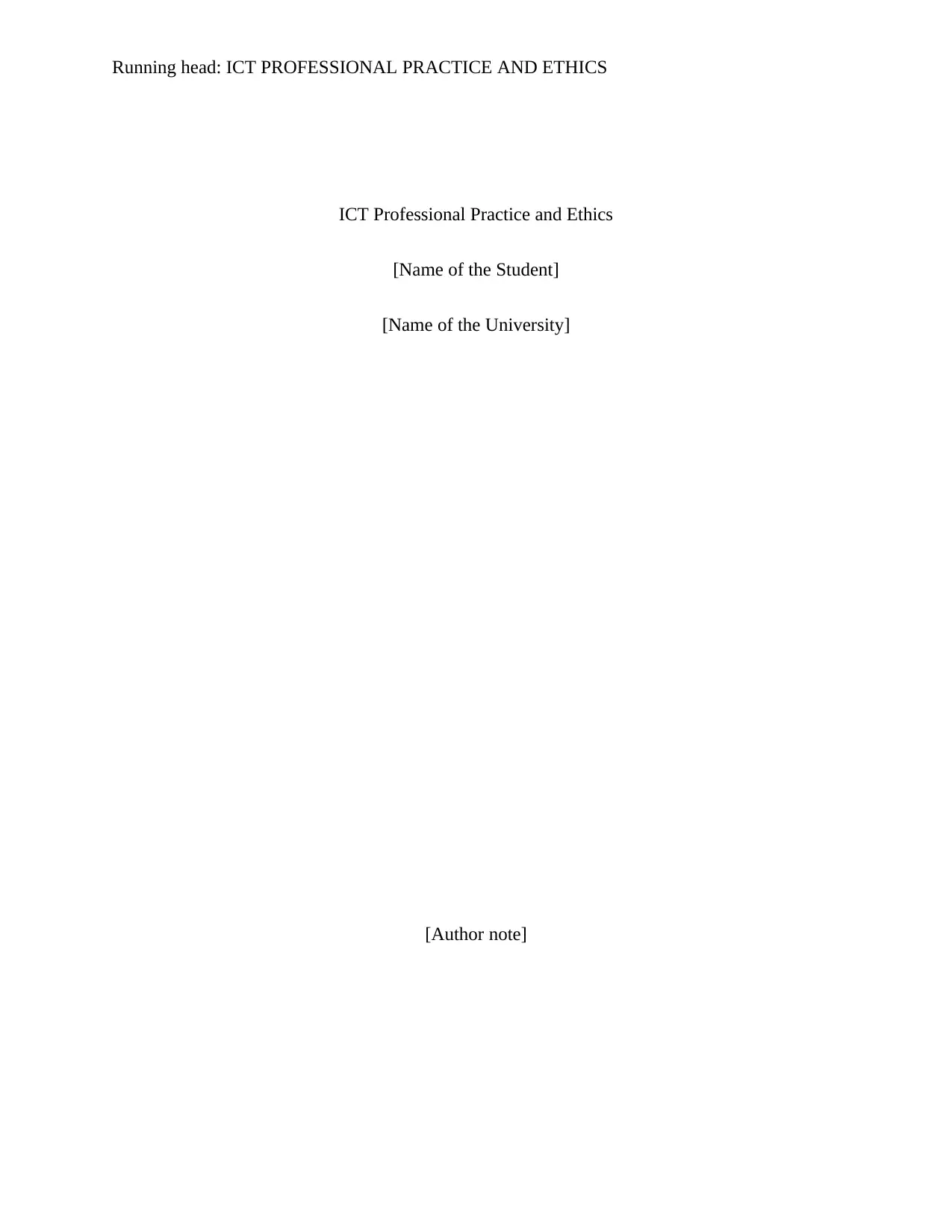
Running head: ICT PROFESSIONAL PRACTICE AND ETHICS
ICT Professional Practice and Ethics
[Name of the Student]
[Name of the University]
[Author note]
ICT Professional Practice and Ethics
[Name of the Student]
[Name of the University]
[Author note]
Paraphrase This Document
Need a fresh take? Get an instant paraphrase of this document with our AI Paraphraser
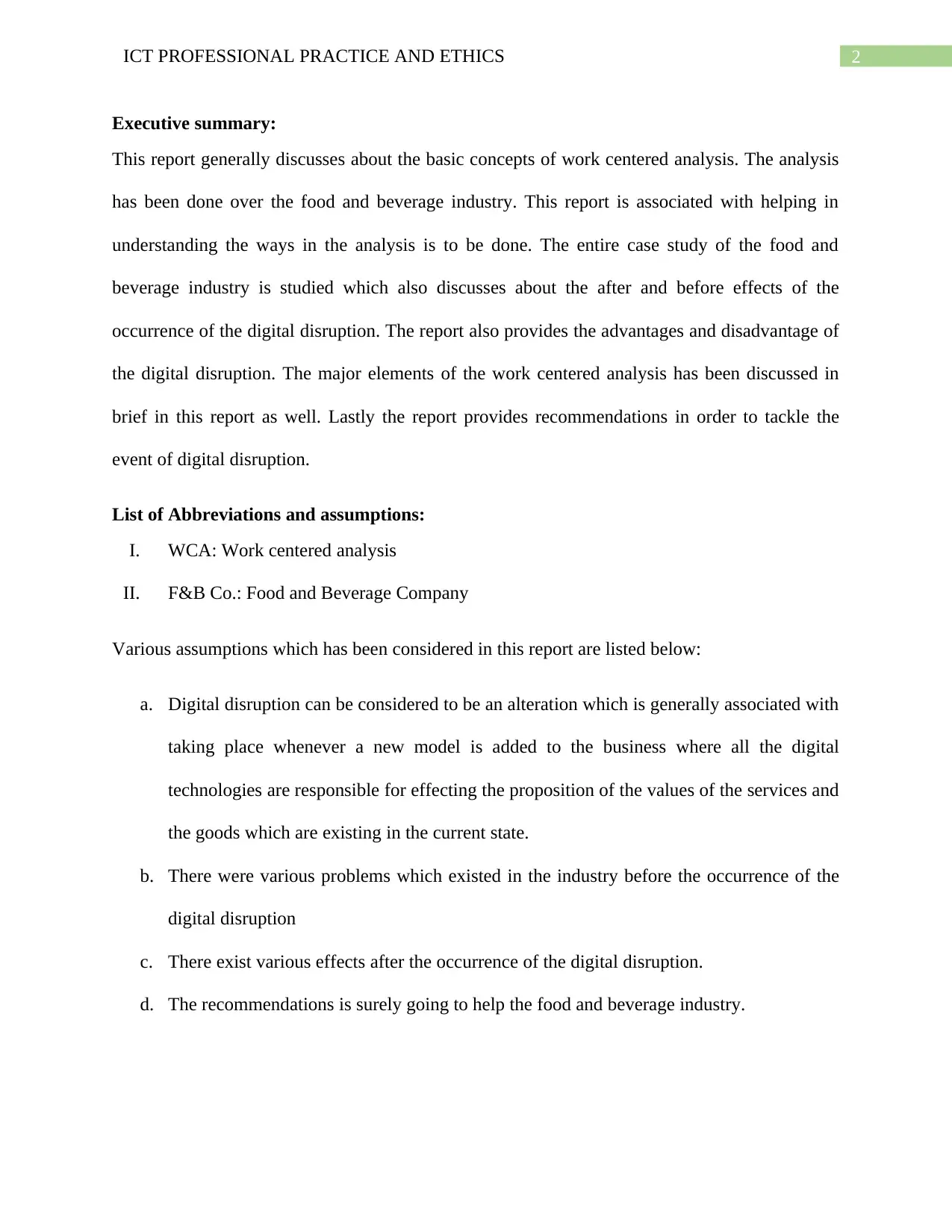
2ICT PROFESSIONAL PRACTICE AND ETHICS
Executive summary:
This report generally discusses about the basic concepts of work centered analysis. The analysis
has been done over the food and beverage industry. This report is associated with helping in
understanding the ways in the analysis is to be done. The entire case study of the food and
beverage industry is studied which also discusses about the after and before effects of the
occurrence of the digital disruption. The report also provides the advantages and disadvantage of
the digital disruption. The major elements of the work centered analysis has been discussed in
brief in this report as well. Lastly the report provides recommendations in order to tackle the
event of digital disruption.
List of Abbreviations and assumptions:
I. WCA: Work centered analysis
II. F&B Co.: Food and Beverage Company
Various assumptions which has been considered in this report are listed below:
a. Digital disruption can be considered to be an alteration which is generally associated with
taking place whenever a new model is added to the business where all the digital
technologies are responsible for effecting the proposition of the values of the services and
the goods which are existing in the current state.
b. There were various problems which existed in the industry before the occurrence of the
digital disruption
c. There exist various effects after the occurrence of the digital disruption.
d. The recommendations is surely going to help the food and beverage industry.
Executive summary:
This report generally discusses about the basic concepts of work centered analysis. The analysis
has been done over the food and beverage industry. This report is associated with helping in
understanding the ways in the analysis is to be done. The entire case study of the food and
beverage industry is studied which also discusses about the after and before effects of the
occurrence of the digital disruption. The report also provides the advantages and disadvantage of
the digital disruption. The major elements of the work centered analysis has been discussed in
brief in this report as well. Lastly the report provides recommendations in order to tackle the
event of digital disruption.
List of Abbreviations and assumptions:
I. WCA: Work centered analysis
II. F&B Co.: Food and Beverage Company
Various assumptions which has been considered in this report are listed below:
a. Digital disruption can be considered to be an alteration which is generally associated with
taking place whenever a new model is added to the business where all the digital
technologies are responsible for effecting the proposition of the values of the services and
the goods which are existing in the current state.
b. There were various problems which existed in the industry before the occurrence of the
digital disruption
c. There exist various effects after the occurrence of the digital disruption.
d. The recommendations is surely going to help the food and beverage industry.
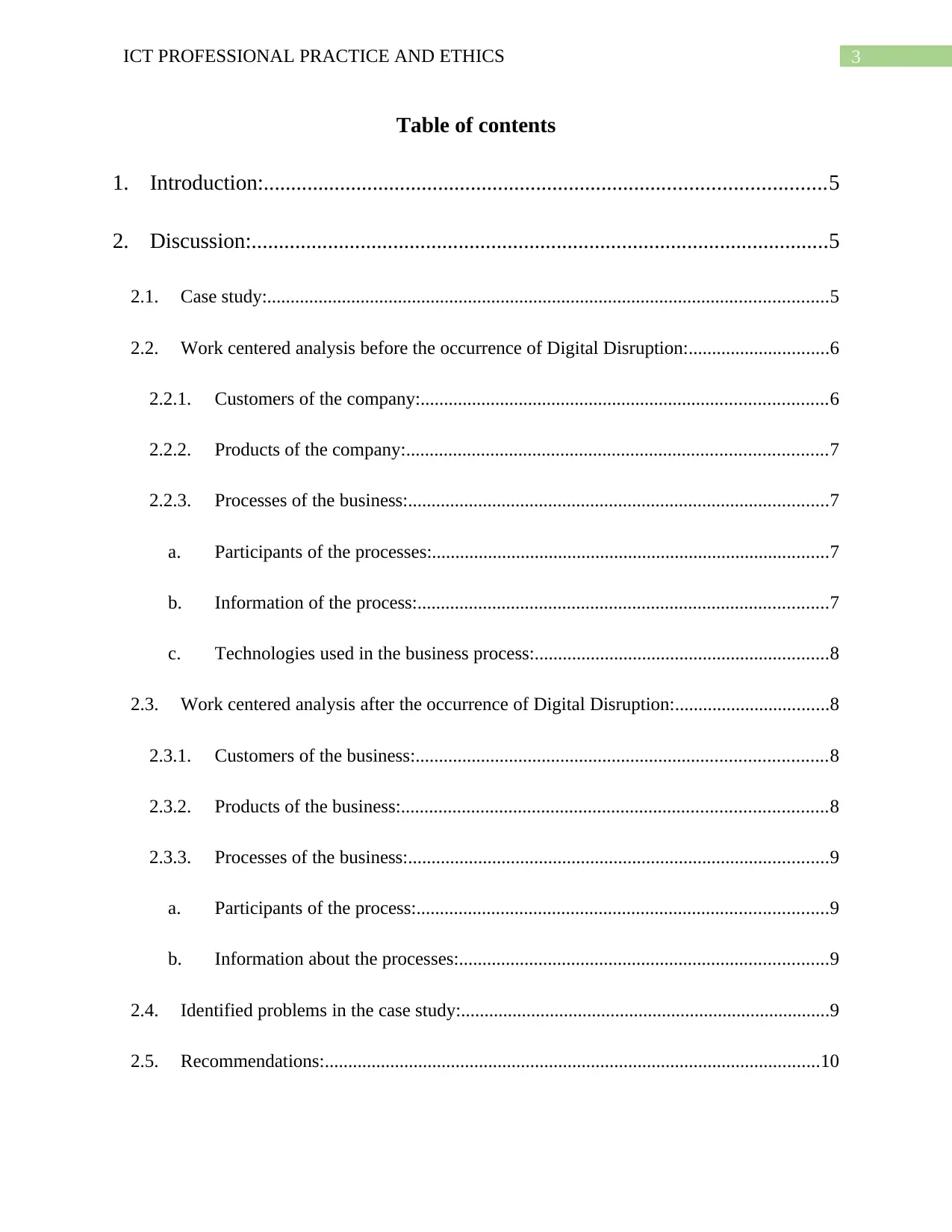
3ICT PROFESSIONAL PRACTICE AND ETHICS
Table of contents
1. Introduction:.......................................................................................................5
2. Discussion:..........................................................................................................5
2.1. Case study:........................................................................................................................5
2.2. Work centered analysis before the occurrence of Digital Disruption:..............................6
2.2.1. Customers of the company:.......................................................................................6
2.2.2. Products of the company:..........................................................................................7
2.2.3. Processes of the business:..........................................................................................7
a. Participants of the processes:.....................................................................................7
b. Information of the process:........................................................................................7
c. Technologies used in the business process:...............................................................8
2.3. Work centered analysis after the occurrence of Digital Disruption:.................................8
2.3.1. Customers of the business:........................................................................................8
2.3.2. Products of the business:...........................................................................................8
2.3.3. Processes of the business:..........................................................................................9
a. Participants of the process:........................................................................................9
b. Information about the processes:...............................................................................9
2.4. Identified problems in the case study:...............................................................................9
2.5. Recommendations:..........................................................................................................10
Table of contents
1. Introduction:.......................................................................................................5
2. Discussion:..........................................................................................................5
2.1. Case study:........................................................................................................................5
2.2. Work centered analysis before the occurrence of Digital Disruption:..............................6
2.2.1. Customers of the company:.......................................................................................6
2.2.2. Products of the company:..........................................................................................7
2.2.3. Processes of the business:..........................................................................................7
a. Participants of the processes:.....................................................................................7
b. Information of the process:........................................................................................7
c. Technologies used in the business process:...............................................................8
2.3. Work centered analysis after the occurrence of Digital Disruption:.................................8
2.3.1. Customers of the business:........................................................................................8
2.3.2. Products of the business:...........................................................................................8
2.3.3. Processes of the business:..........................................................................................9
a. Participants of the process:........................................................................................9
b. Information about the processes:...............................................................................9
2.4. Identified problems in the case study:...............................................................................9
2.5. Recommendations:..........................................................................................................10
⊘ This is a preview!⊘
Do you want full access?
Subscribe today to unlock all pages.

Trusted by 1+ million students worldwide
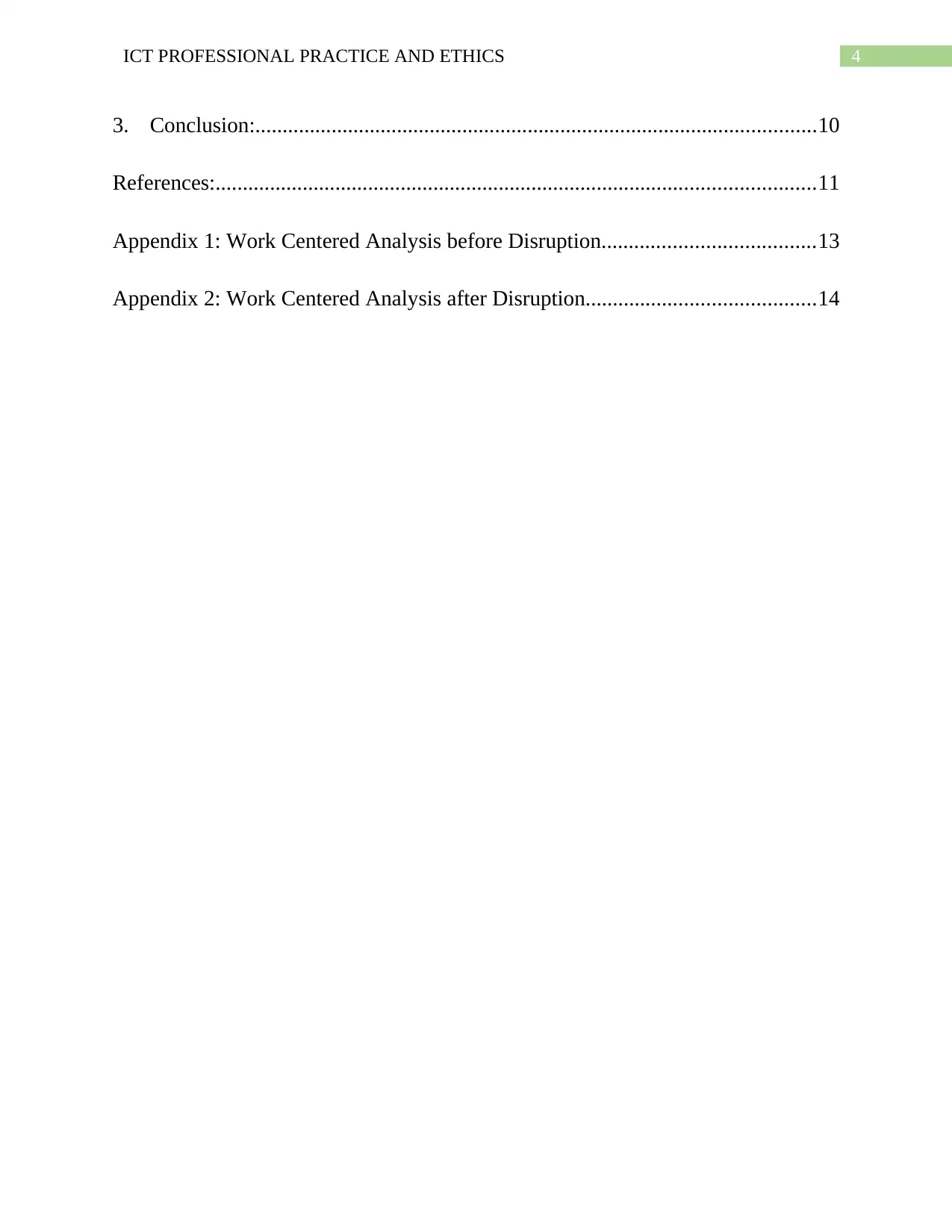
4ICT PROFESSIONAL PRACTICE AND ETHICS
3. Conclusion:.......................................................................................................10
References:..............................................................................................................11
Appendix 1: Work Centered Analysis before Disruption.......................................13
Appendix 2: Work Centered Analysis after Disruption..........................................14
3. Conclusion:.......................................................................................................10
References:..............................................................................................................11
Appendix 1: Work Centered Analysis before Disruption.......................................13
Appendix 2: Work Centered Analysis after Disruption..........................................14
Paraphrase This Document
Need a fresh take? Get an instant paraphrase of this document with our AI Paraphraser
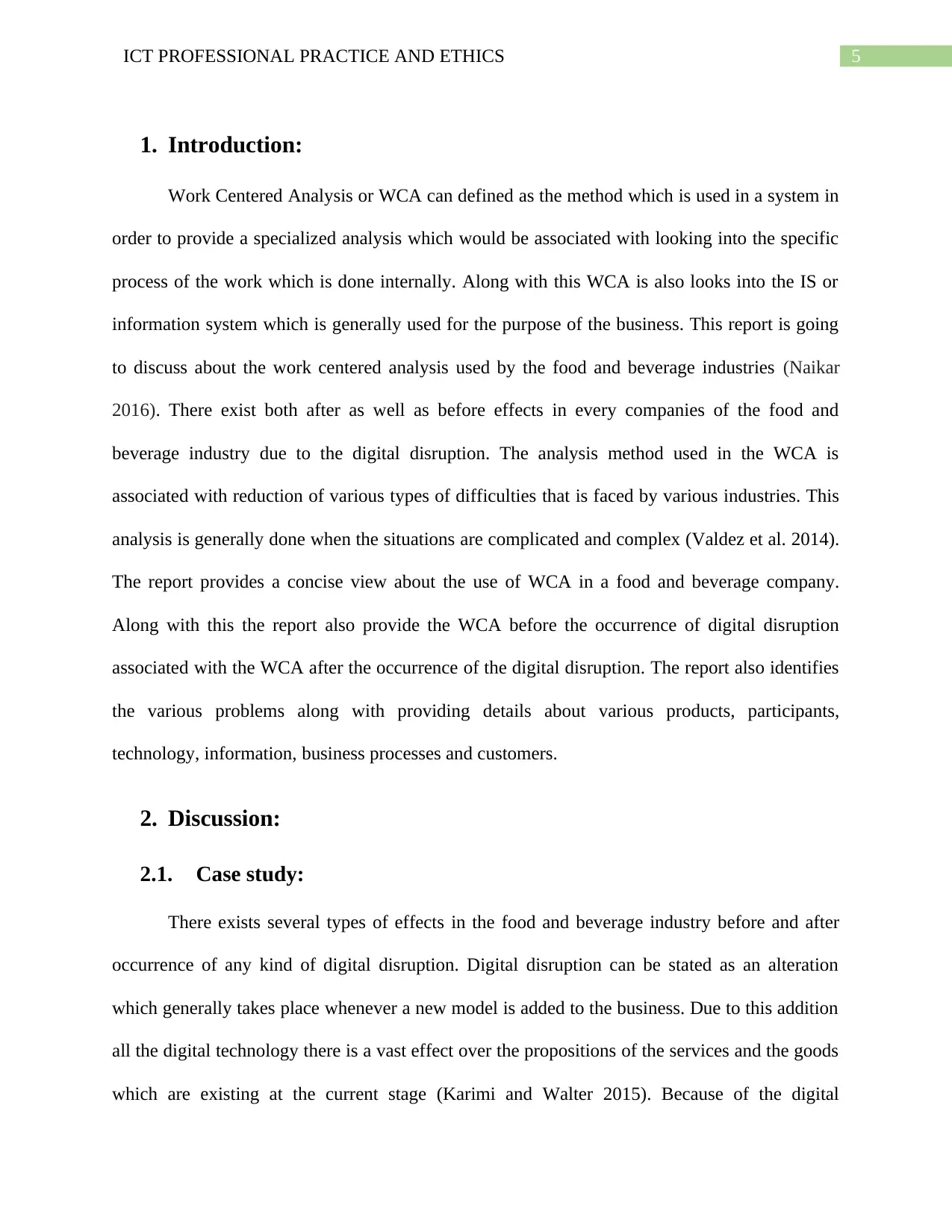
5ICT PROFESSIONAL PRACTICE AND ETHICS
1. Introduction:
Work Centered Analysis or WCA can defined as the method which is used in a system in
order to provide a specialized analysis which would be associated with looking into the specific
process of the work which is done internally. Along with this WCA is also looks into the IS or
information system which is generally used for the purpose of the business. This report is going
to discuss about the work centered analysis used by the food and beverage industries (Naikar
2016). There exist both after as well as before effects in every companies of the food and
beverage industry due to the digital disruption. The analysis method used in the WCA is
associated with reduction of various types of difficulties that is faced by various industries. This
analysis is generally done when the situations are complicated and complex (Valdez et al. 2014).
The report provides a concise view about the use of WCA in a food and beverage company.
Along with this the report also provide the WCA before the occurrence of digital disruption
associated with the WCA after the occurrence of the digital disruption. The report also identifies
the various problems along with providing details about various products, participants,
technology, information, business processes and customers.
2. Discussion:
2.1. Case study:
There exists several types of effects in the food and beverage industry before and after
occurrence of any kind of digital disruption. Digital disruption can be stated as an alteration
which generally takes place whenever a new model is added to the business. Due to this addition
all the digital technology there is a vast effect over the propositions of the services and the goods
which are existing at the current stage (Karimi and Walter 2015). Because of the digital
1. Introduction:
Work Centered Analysis or WCA can defined as the method which is used in a system in
order to provide a specialized analysis which would be associated with looking into the specific
process of the work which is done internally. Along with this WCA is also looks into the IS or
information system which is generally used for the purpose of the business. This report is going
to discuss about the work centered analysis used by the food and beverage industries (Naikar
2016). There exist both after as well as before effects in every companies of the food and
beverage industry due to the digital disruption. The analysis method used in the WCA is
associated with reduction of various types of difficulties that is faced by various industries. This
analysis is generally done when the situations are complicated and complex (Valdez et al. 2014).
The report provides a concise view about the use of WCA in a food and beverage company.
Along with this the report also provide the WCA before the occurrence of digital disruption
associated with the WCA after the occurrence of the digital disruption. The report also identifies
the various problems along with providing details about various products, participants,
technology, information, business processes and customers.
2. Discussion:
2.1. Case study:
There exists several types of effects in the food and beverage industry before and after
occurrence of any kind of digital disruption. Digital disruption can be stated as an alteration
which generally takes place whenever a new model is added to the business. Due to this addition
all the digital technology there is a vast effect over the propositions of the services and the goods
which are existing at the current stage (Karimi and Walter 2015). Because of the digital
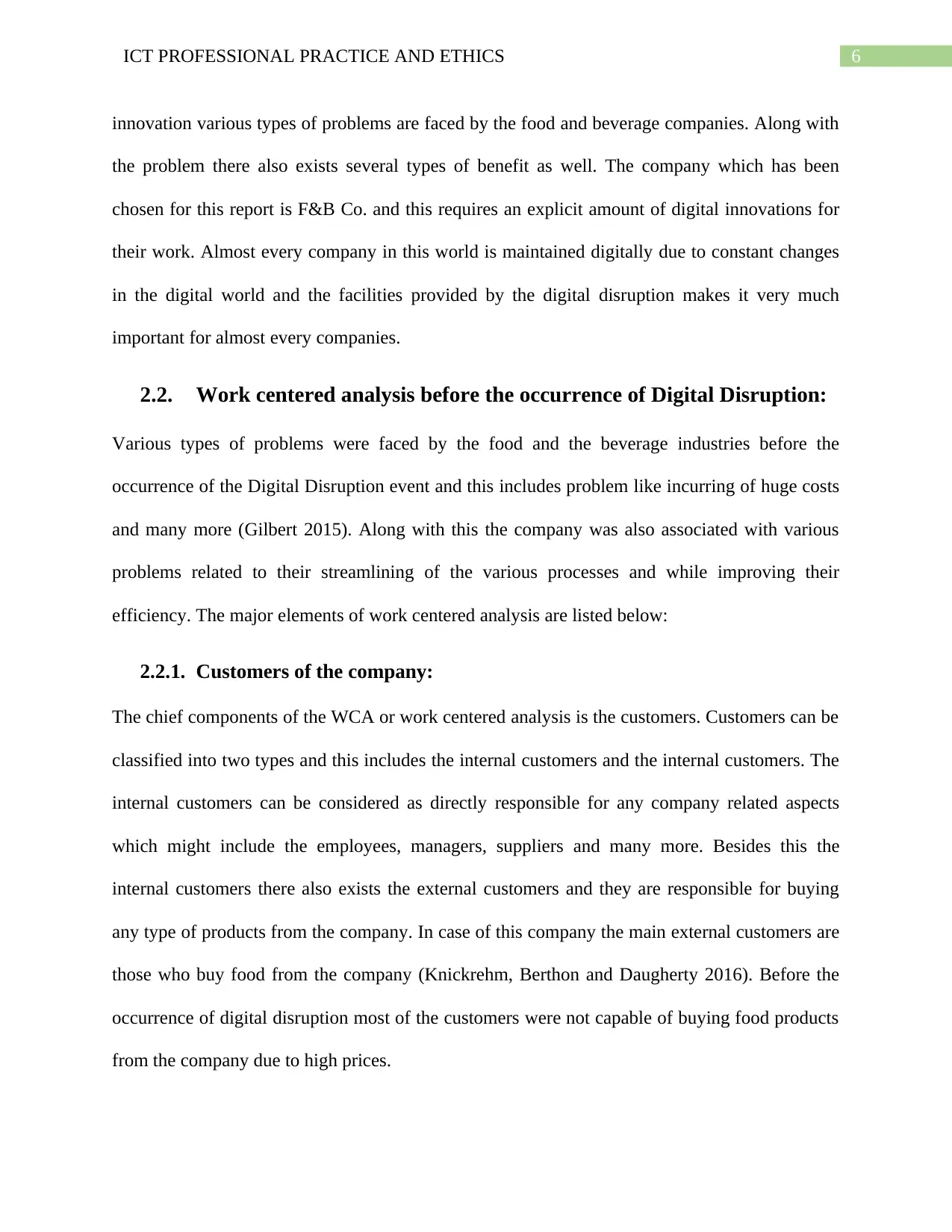
6ICT PROFESSIONAL PRACTICE AND ETHICS
innovation various types of problems are faced by the food and beverage companies. Along with
the problem there also exists several types of benefit as well. The company which has been
chosen for this report is F&B Co. and this requires an explicit amount of digital innovations for
their work. Almost every company in this world is maintained digitally due to constant changes
in the digital world and the facilities provided by the digital disruption makes it very much
important for almost every companies.
2.2. Work centered analysis before the occurrence of Digital Disruption:
Various types of problems were faced by the food and the beverage industries before the
occurrence of the Digital Disruption event and this includes problem like incurring of huge costs
and many more (Gilbert 2015). Along with this the company was also associated with various
problems related to their streamlining of the various processes and while improving their
efficiency. The major elements of work centered analysis are listed below:
2.2.1. Customers of the company:
The chief components of the WCA or work centered analysis is the customers. Customers can be
classified into two types and this includes the internal customers and the internal customers. The
internal customers can be considered as directly responsible for any company related aspects
which might include the employees, managers, suppliers and many more. Besides this the
internal customers there also exists the external customers and they are responsible for buying
any type of products from the company. In case of this company the main external customers are
those who buy food from the company (Knickrehm, Berthon and Daugherty 2016). Before the
occurrence of digital disruption most of the customers were not capable of buying food products
from the company due to high prices.
innovation various types of problems are faced by the food and beverage companies. Along with
the problem there also exists several types of benefit as well. The company which has been
chosen for this report is F&B Co. and this requires an explicit amount of digital innovations for
their work. Almost every company in this world is maintained digitally due to constant changes
in the digital world and the facilities provided by the digital disruption makes it very much
important for almost every companies.
2.2. Work centered analysis before the occurrence of Digital Disruption:
Various types of problems were faced by the food and the beverage industries before the
occurrence of the Digital Disruption event and this includes problem like incurring of huge costs
and many more (Gilbert 2015). Along with this the company was also associated with various
problems related to their streamlining of the various processes and while improving their
efficiency. The major elements of work centered analysis are listed below:
2.2.1. Customers of the company:
The chief components of the WCA or work centered analysis is the customers. Customers can be
classified into two types and this includes the internal customers and the internal customers. The
internal customers can be considered as directly responsible for any company related aspects
which might include the employees, managers, suppliers and many more. Besides this the
internal customers there also exists the external customers and they are responsible for buying
any type of products from the company. In case of this company the main external customers are
those who buy food from the company (Knickrehm, Berthon and Daugherty 2016). Before the
occurrence of digital disruption most of the customers were not capable of buying food products
from the company due to high prices.
⊘ This is a preview!⊘
Do you want full access?
Subscribe today to unlock all pages.

Trusted by 1+ million students worldwide
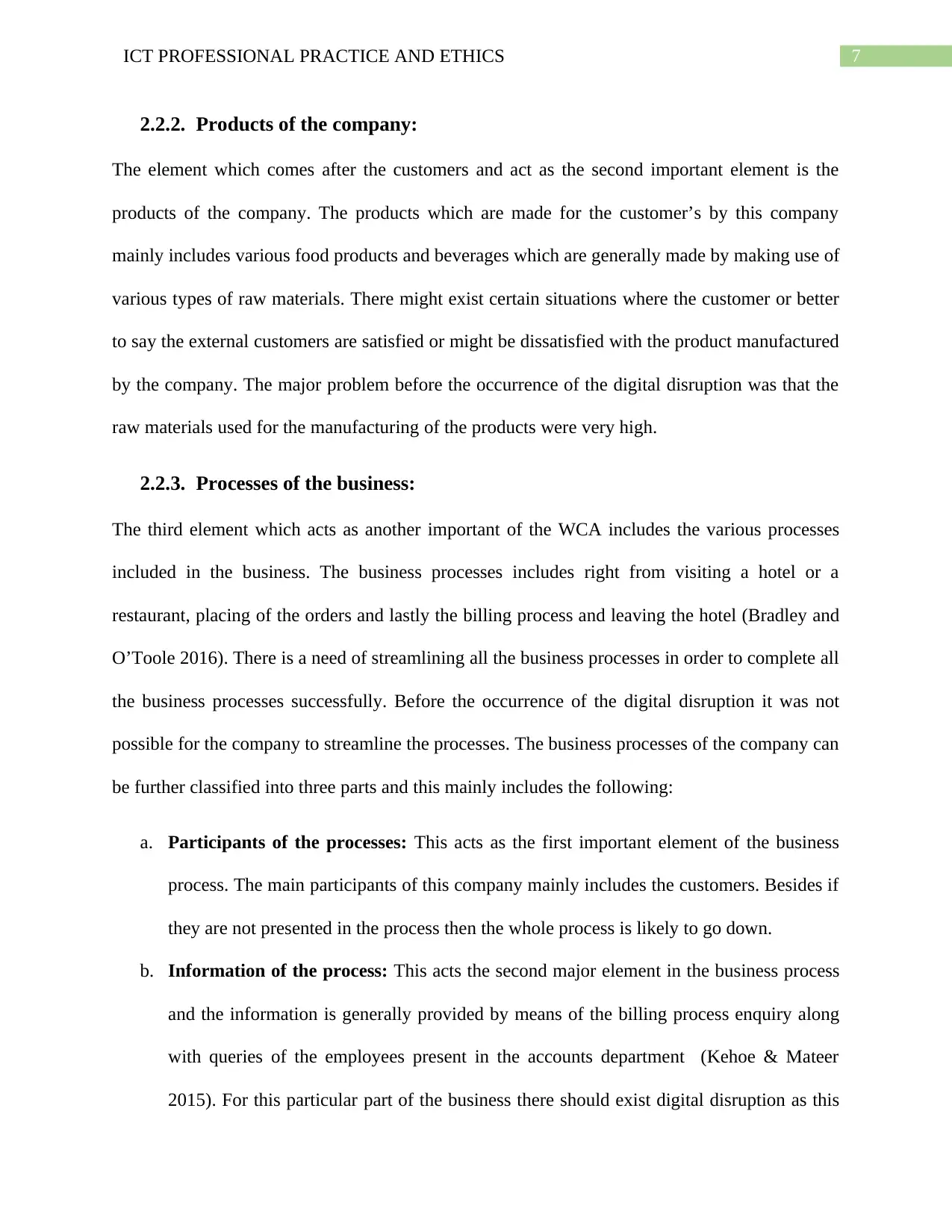
7ICT PROFESSIONAL PRACTICE AND ETHICS
2.2.2. Products of the company:
The element which comes after the customers and act as the second important element is the
products of the company. The products which are made for the customer’s by this company
mainly includes various food products and beverages which are generally made by making use of
various types of raw materials. There might exist certain situations where the customer or better
to say the external customers are satisfied or might be dissatisfied with the product manufactured
by the company. The major problem before the occurrence of the digital disruption was that the
raw materials used for the manufacturing of the products were very high.
2.2.3. Processes of the business:
The third element which acts as another important of the WCA includes the various processes
included in the business. The business processes includes right from visiting a hotel or a
restaurant, placing of the orders and lastly the billing process and leaving the hotel (Bradley and
O’Toole 2016). There is a need of streamlining all the business processes in order to complete all
the business processes successfully. Before the occurrence of the digital disruption it was not
possible for the company to streamline the processes. The business processes of the company can
be further classified into three parts and this mainly includes the following:
a. Participants of the processes: This acts as the first important element of the business
process. The main participants of this company mainly includes the customers. Besides if
they are not presented in the process then the whole process is likely to go down.
b. Information of the process: This acts the second major element in the business process
and the information is generally provided by means of the billing process enquiry along
with queries of the employees present in the accounts department (Kehoe & Mateer
2015). For this particular part of the business there should exist digital disruption as this
2.2.2. Products of the company:
The element which comes after the customers and act as the second important element is the
products of the company. The products which are made for the customer’s by this company
mainly includes various food products and beverages which are generally made by making use of
various types of raw materials. There might exist certain situations where the customer or better
to say the external customers are satisfied or might be dissatisfied with the product manufactured
by the company. The major problem before the occurrence of the digital disruption was that the
raw materials used for the manufacturing of the products were very high.
2.2.3. Processes of the business:
The third element which acts as another important of the WCA includes the various processes
included in the business. The business processes includes right from visiting a hotel or a
restaurant, placing of the orders and lastly the billing process and leaving the hotel (Bradley and
O’Toole 2016). There is a need of streamlining all the business processes in order to complete all
the business processes successfully. Before the occurrence of the digital disruption it was not
possible for the company to streamline the processes. The business processes of the company can
be further classified into three parts and this mainly includes the following:
a. Participants of the processes: This acts as the first important element of the business
process. The main participants of this company mainly includes the customers. Besides if
they are not presented in the process then the whole process is likely to go down.
b. Information of the process: This acts the second major element in the business process
and the information is generally provided by means of the billing process enquiry along
with queries of the employees present in the accounts department (Kehoe & Mateer
2015). For this particular part of the business there should exist digital disruption as this
Paraphrase This Document
Need a fresh take? Get an instant paraphrase of this document with our AI Paraphraser
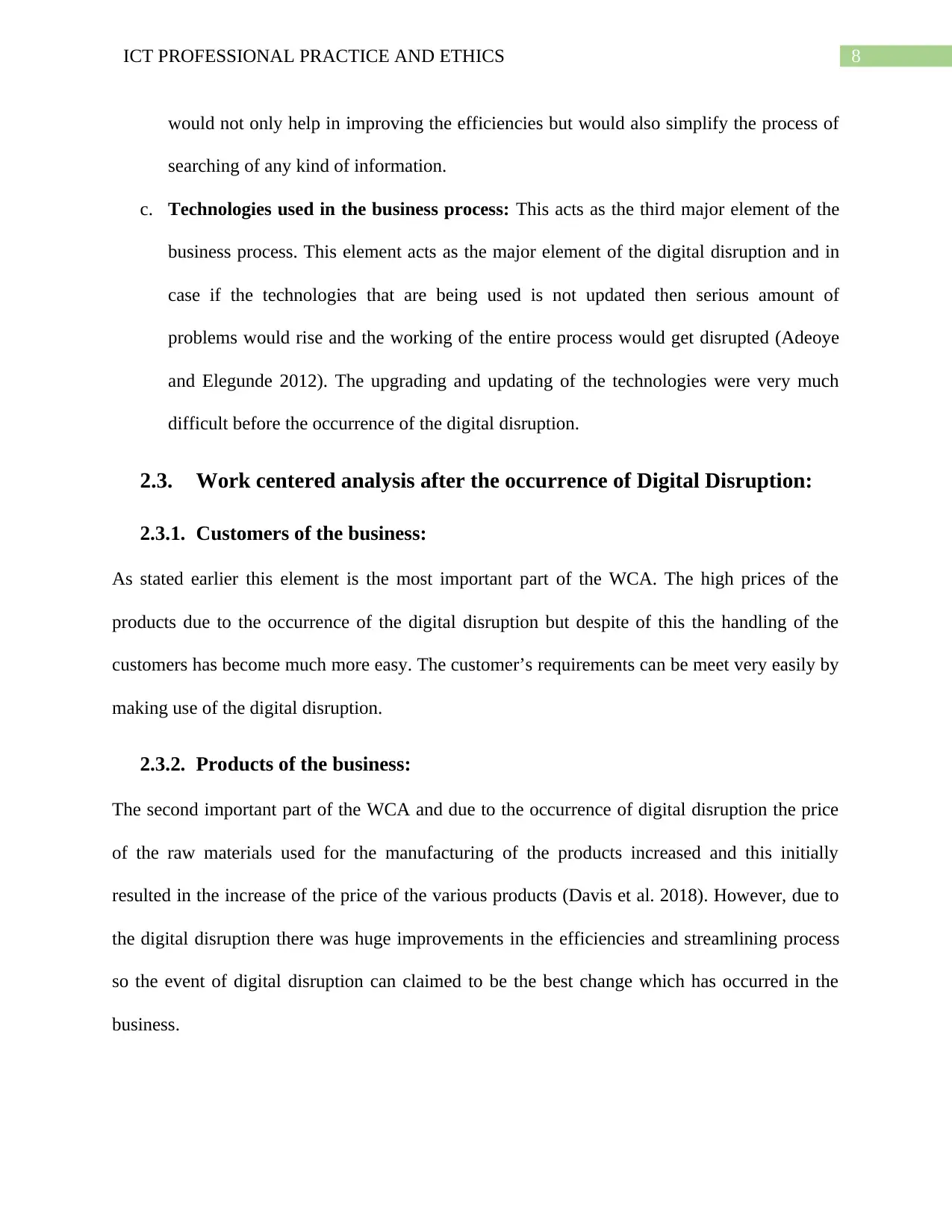
8ICT PROFESSIONAL PRACTICE AND ETHICS
would not only help in improving the efficiencies but would also simplify the process of
searching of any kind of information.
c. Technologies used in the business process: This acts as the third major element of the
business process. This element acts as the major element of the digital disruption and in
case if the technologies that are being used is not updated then serious amount of
problems would rise and the working of the entire process would get disrupted (Adeoye
and Elegunde 2012). The upgrading and updating of the technologies were very much
difficult before the occurrence of the digital disruption.
2.3. Work centered analysis after the occurrence of Digital Disruption:
2.3.1. Customers of the business:
As stated earlier this element is the most important part of the WCA. The high prices of the
products due to the occurrence of the digital disruption but despite of this the handling of the
customers has become much more easy. The customer’s requirements can be meet very easily by
making use of the digital disruption.
2.3.2. Products of the business:
The second important part of the WCA and due to the occurrence of digital disruption the price
of the raw materials used for the manufacturing of the products increased and this initially
resulted in the increase of the price of the various products (Davis et al. 2018). However, due to
the digital disruption there was huge improvements in the efficiencies and streamlining process
so the event of digital disruption can claimed to be the best change which has occurred in the
business.
would not only help in improving the efficiencies but would also simplify the process of
searching of any kind of information.
c. Technologies used in the business process: This acts as the third major element of the
business process. This element acts as the major element of the digital disruption and in
case if the technologies that are being used is not updated then serious amount of
problems would rise and the working of the entire process would get disrupted (Adeoye
and Elegunde 2012). The upgrading and updating of the technologies were very much
difficult before the occurrence of the digital disruption.
2.3. Work centered analysis after the occurrence of Digital Disruption:
2.3.1. Customers of the business:
As stated earlier this element is the most important part of the WCA. The high prices of the
products due to the occurrence of the digital disruption but despite of this the handling of the
customers has become much more easy. The customer’s requirements can be meet very easily by
making use of the digital disruption.
2.3.2. Products of the business:
The second important part of the WCA and due to the occurrence of digital disruption the price
of the raw materials used for the manufacturing of the products increased and this initially
resulted in the increase of the price of the various products (Davis et al. 2018). However, due to
the digital disruption there was huge improvements in the efficiencies and streamlining process
so the event of digital disruption can claimed to be the best change which has occurred in the
business.
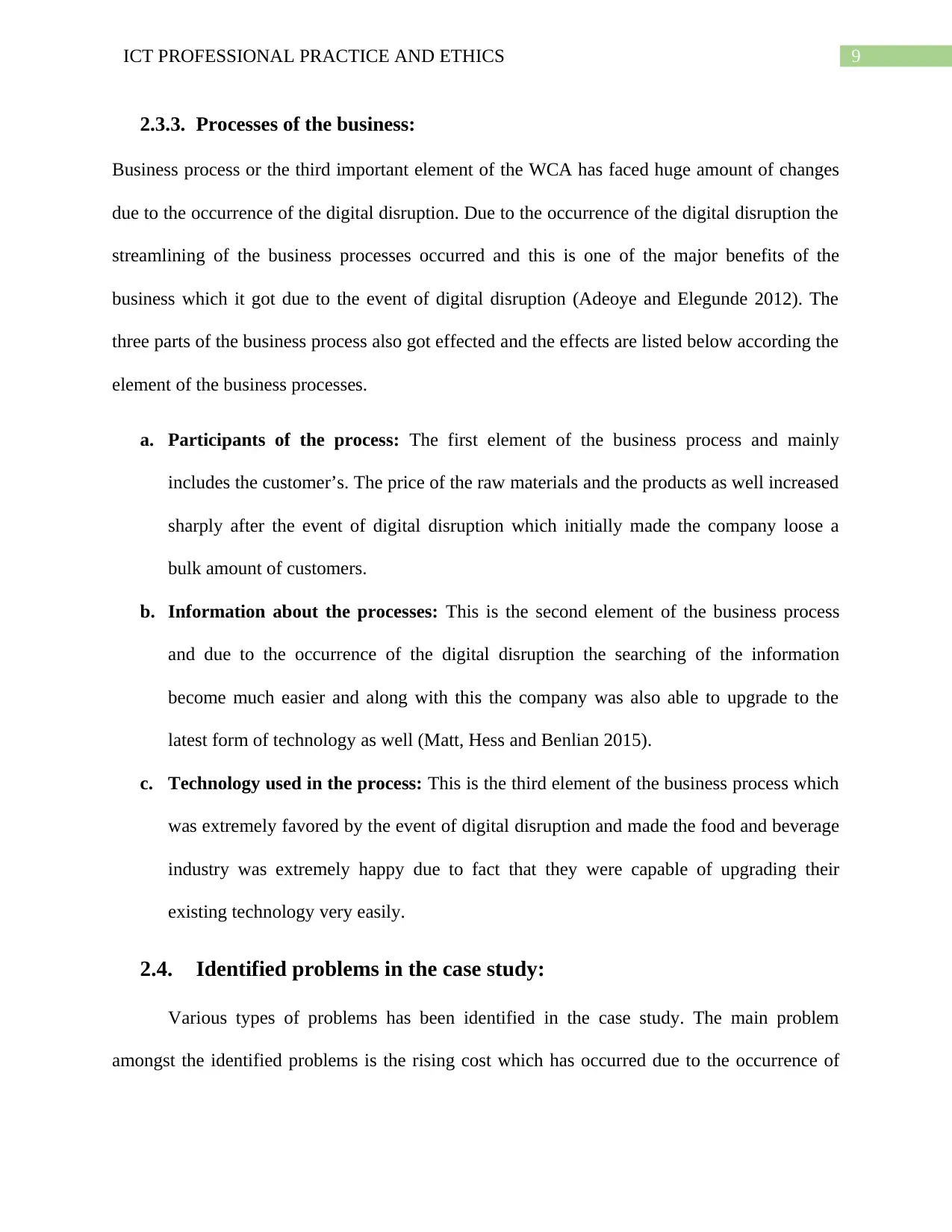
9ICT PROFESSIONAL PRACTICE AND ETHICS
2.3.3. Processes of the business:
Business process or the third important element of the WCA has faced huge amount of changes
due to the occurrence of the digital disruption. Due to the occurrence of the digital disruption the
streamlining of the business processes occurred and this is one of the major benefits of the
business which it got due to the event of digital disruption (Adeoye and Elegunde 2012). The
three parts of the business process also got effected and the effects are listed below according the
element of the business processes.
a. Participants of the process: The first element of the business process and mainly
includes the customer’s. The price of the raw materials and the products as well increased
sharply after the event of digital disruption which initially made the company loose a
bulk amount of customers.
b. Information about the processes: This is the second element of the business process
and due to the occurrence of the digital disruption the searching of the information
become much easier and along with this the company was also able to upgrade to the
latest form of technology as well (Matt, Hess and Benlian 2015).
c. Technology used in the process: This is the third element of the business process which
was extremely favored by the event of digital disruption and made the food and beverage
industry was extremely happy due to fact that they were capable of upgrading their
existing technology very easily.
2.4. Identified problems in the case study:
Various types of problems has been identified in the case study. The main problem
amongst the identified problems is the rising cost which has occurred due to the occurrence of
2.3.3. Processes of the business:
Business process or the third important element of the WCA has faced huge amount of changes
due to the occurrence of the digital disruption. Due to the occurrence of the digital disruption the
streamlining of the business processes occurred and this is one of the major benefits of the
business which it got due to the event of digital disruption (Adeoye and Elegunde 2012). The
three parts of the business process also got effected and the effects are listed below according the
element of the business processes.
a. Participants of the process: The first element of the business process and mainly
includes the customer’s. The price of the raw materials and the products as well increased
sharply after the event of digital disruption which initially made the company loose a
bulk amount of customers.
b. Information about the processes: This is the second element of the business process
and due to the occurrence of the digital disruption the searching of the information
become much easier and along with this the company was also able to upgrade to the
latest form of technology as well (Matt, Hess and Benlian 2015).
c. Technology used in the process: This is the third element of the business process which
was extremely favored by the event of digital disruption and made the food and beverage
industry was extremely happy due to fact that they were capable of upgrading their
existing technology very easily.
2.4. Identified problems in the case study:
Various types of problems has been identified in the case study. The main problem
amongst the identified problems is the rising cost which has occurred due to the occurrence of
⊘ This is a preview!⊘
Do you want full access?
Subscribe today to unlock all pages.

Trusted by 1+ million students worldwide
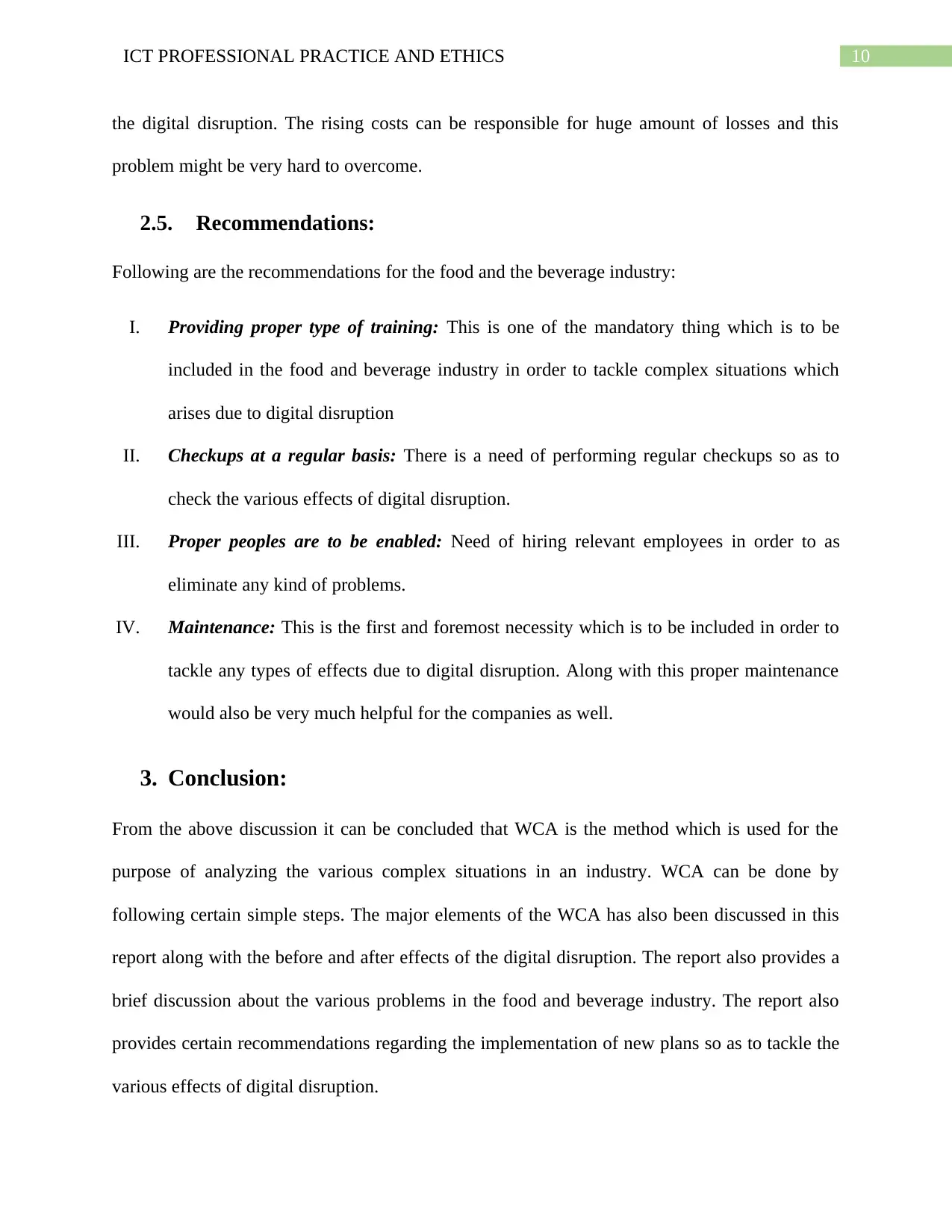
10ICT PROFESSIONAL PRACTICE AND ETHICS
the digital disruption. The rising costs can be responsible for huge amount of losses and this
problem might be very hard to overcome.
2.5. Recommendations:
Following are the recommendations for the food and the beverage industry:
I. Providing proper type of training: This is one of the mandatory thing which is to be
included in the food and beverage industry in order to tackle complex situations which
arises due to digital disruption
II. Checkups at a regular basis: There is a need of performing regular checkups so as to
check the various effects of digital disruption.
III. Proper peoples are to be enabled: Need of hiring relevant employees in order to as
eliminate any kind of problems.
IV. Maintenance: This is the first and foremost necessity which is to be included in order to
tackle any types of effects due to digital disruption. Along with this proper maintenance
would also be very much helpful for the companies as well.
3. Conclusion:
From the above discussion it can be concluded that WCA is the method which is used for the
purpose of analyzing the various complex situations in an industry. WCA can be done by
following certain simple steps. The major elements of the WCA has also been discussed in this
report along with the before and after effects of the digital disruption. The report also provides a
brief discussion about the various problems in the food and beverage industry. The report also
provides certain recommendations regarding the implementation of new plans so as to tackle the
various effects of digital disruption.
the digital disruption. The rising costs can be responsible for huge amount of losses and this
problem might be very hard to overcome.
2.5. Recommendations:
Following are the recommendations for the food and the beverage industry:
I. Providing proper type of training: This is one of the mandatory thing which is to be
included in the food and beverage industry in order to tackle complex situations which
arises due to digital disruption
II. Checkups at a regular basis: There is a need of performing regular checkups so as to
check the various effects of digital disruption.
III. Proper peoples are to be enabled: Need of hiring relevant employees in order to as
eliminate any kind of problems.
IV. Maintenance: This is the first and foremost necessity which is to be included in order to
tackle any types of effects due to digital disruption. Along with this proper maintenance
would also be very much helpful for the companies as well.
3. Conclusion:
From the above discussion it can be concluded that WCA is the method which is used for the
purpose of analyzing the various complex situations in an industry. WCA can be done by
following certain simple steps. The major elements of the WCA has also been discussed in this
report along with the before and after effects of the digital disruption. The report also provides a
brief discussion about the various problems in the food and beverage industry. The report also
provides certain recommendations regarding the implementation of new plans so as to tackle the
various effects of digital disruption.
Paraphrase This Document
Need a fresh take? Get an instant paraphrase of this document with our AI Paraphraser
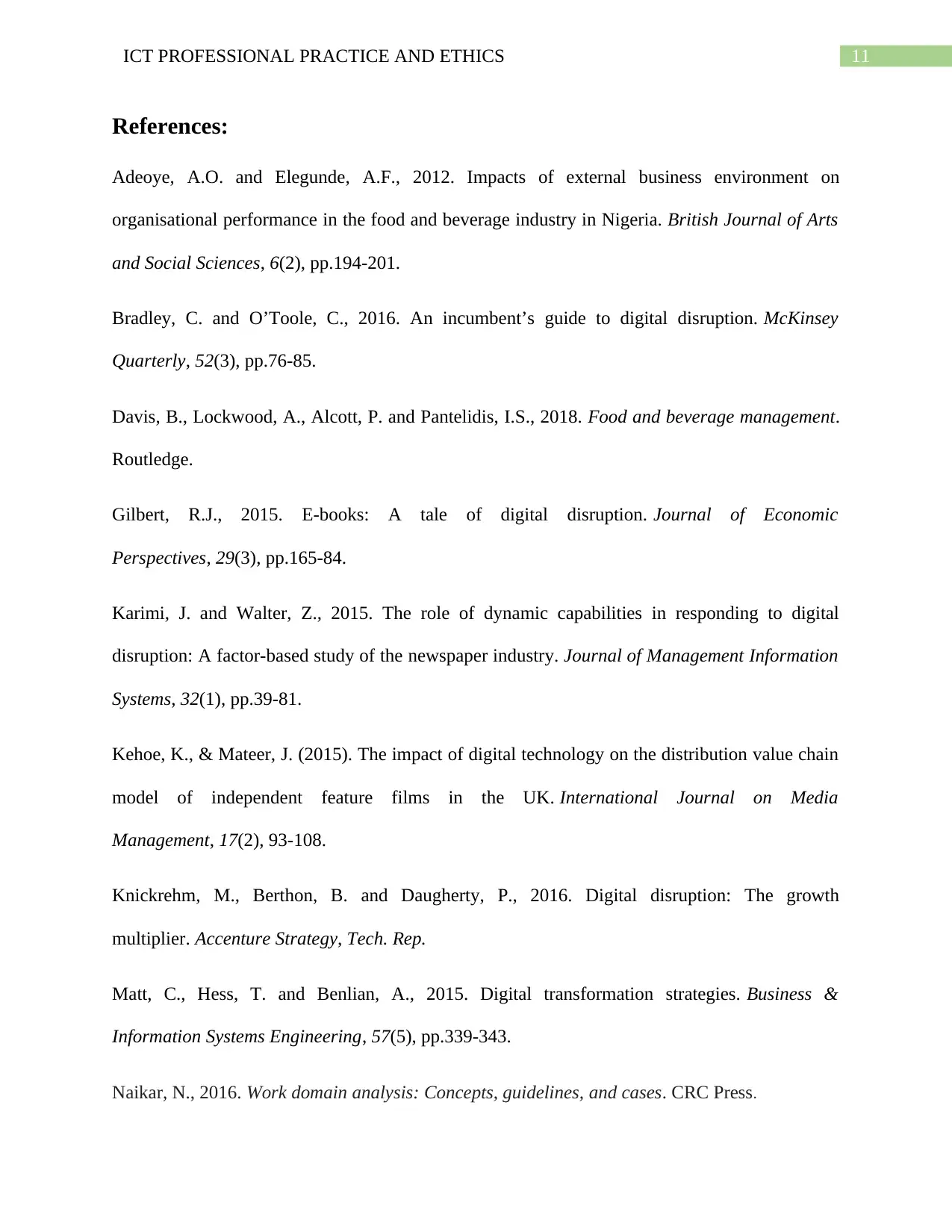
11ICT PROFESSIONAL PRACTICE AND ETHICS
References:
Adeoye, A.O. and Elegunde, A.F., 2012. Impacts of external business environment on
organisational performance in the food and beverage industry in Nigeria. British Journal of Arts
and Social Sciences, 6(2), pp.194-201.
Bradley, C. and O’Toole, C., 2016. An incumbent’s guide to digital disruption. McKinsey
Quarterly, 52(3), pp.76-85.
Davis, B., Lockwood, A., Alcott, P. and Pantelidis, I.S., 2018. Food and beverage management.
Routledge.
Gilbert, R.J., 2015. E-books: A tale of digital disruption. Journal of Economic
Perspectives, 29(3), pp.165-84.
Karimi, J. and Walter, Z., 2015. The role of dynamic capabilities in responding to digital
disruption: A factor-based study of the newspaper industry. Journal of Management Information
Systems, 32(1), pp.39-81.
Kehoe, K., & Mateer, J. (2015). The impact of digital technology on the distribution value chain
model of independent feature films in the UK. International Journal on Media
Management, 17(2), 93-108.
Knickrehm, M., Berthon, B. and Daugherty, P., 2016. Digital disruption: The growth
multiplier. Accenture Strategy, Tech. Rep.
Matt, C., Hess, T. and Benlian, A., 2015. Digital transformation strategies. Business &
Information Systems Engineering, 57(5), pp.339-343.
Naikar, N., 2016. Work domain analysis: Concepts, guidelines, and cases. CRC Press.
References:
Adeoye, A.O. and Elegunde, A.F., 2012. Impacts of external business environment on
organisational performance in the food and beverage industry in Nigeria. British Journal of Arts
and Social Sciences, 6(2), pp.194-201.
Bradley, C. and O’Toole, C., 2016. An incumbent’s guide to digital disruption. McKinsey
Quarterly, 52(3), pp.76-85.
Davis, B., Lockwood, A., Alcott, P. and Pantelidis, I.S., 2018. Food and beverage management.
Routledge.
Gilbert, R.J., 2015. E-books: A tale of digital disruption. Journal of Economic
Perspectives, 29(3), pp.165-84.
Karimi, J. and Walter, Z., 2015. The role of dynamic capabilities in responding to digital
disruption: A factor-based study of the newspaper industry. Journal of Management Information
Systems, 32(1), pp.39-81.
Kehoe, K., & Mateer, J. (2015). The impact of digital technology on the distribution value chain
model of independent feature films in the UK. International Journal on Media
Management, 17(2), 93-108.
Knickrehm, M., Berthon, B. and Daugherty, P., 2016. Digital disruption: The growth
multiplier. Accenture Strategy, Tech. Rep.
Matt, C., Hess, T. and Benlian, A., 2015. Digital transformation strategies. Business &
Information Systems Engineering, 57(5), pp.339-343.
Naikar, N., 2016. Work domain analysis: Concepts, guidelines, and cases. CRC Press.
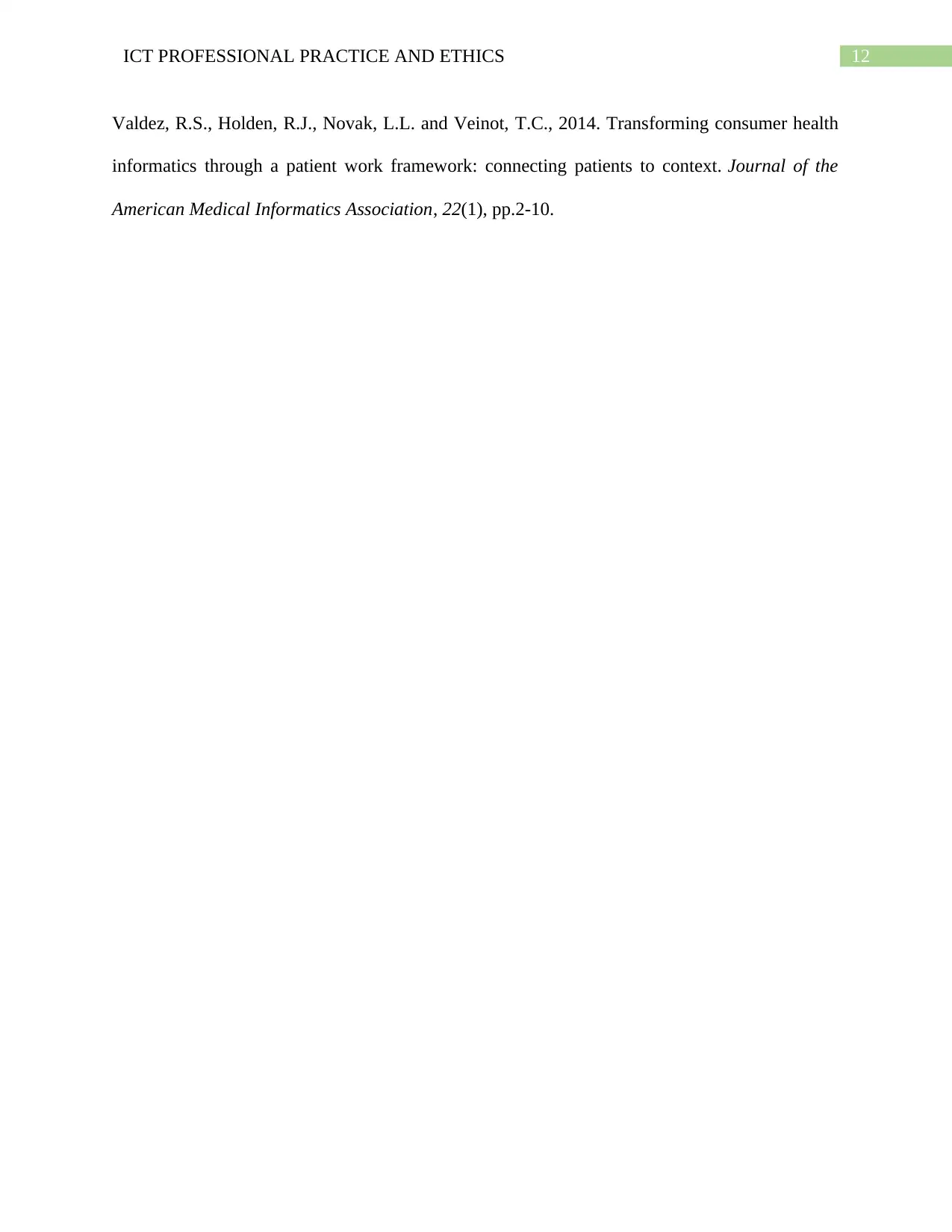
12ICT PROFESSIONAL PRACTICE AND ETHICS
Valdez, R.S., Holden, R.J., Novak, L.L. and Veinot, T.C., 2014. Transforming consumer health
informatics through a patient work framework: connecting patients to context. Journal of the
American Medical Informatics Association, 22(1), pp.2-10.
Valdez, R.S., Holden, R.J., Novak, L.L. and Veinot, T.C., 2014. Transforming consumer health
informatics through a patient work framework: connecting patients to context. Journal of the
American Medical Informatics Association, 22(1), pp.2-10.
⊘ This is a preview!⊘
Do you want full access?
Subscribe today to unlock all pages.

Trusted by 1+ million students worldwide
1 out of 14
Related Documents
Your All-in-One AI-Powered Toolkit for Academic Success.
+13062052269
info@desklib.com
Available 24*7 on WhatsApp / Email
![[object Object]](/_next/static/media/star-bottom.7253800d.svg)
Unlock your academic potential
Copyright © 2020–2025 A2Z Services. All Rights Reserved. Developed and managed by ZUCOL.




